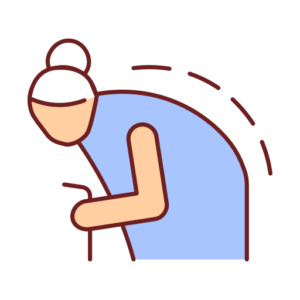KYPHOSIS TREATMENT

Kyphosis is a medical condition characterized by an excessive outward curve in the upper part of the spine, causing a rounded or “hunched” appearance in the back. This article aims to provide comprehensive information about what kyphosis is, why it occurs, how it is diagnosed, and the available non-surgical and surgical treatment options.
What is Kyphosis?
The human spine naturally has curves that assist in absorbing shock, maintaining balance, and allowing the range of motion. A healthy thoracic spine or the upper back should have a slight kyphotic curve, ranging from 20 to 45 degrees. However, when this curve exceeds 50 degrees, it is classified as kyphosis.
Kyphosis can affect people of all ages and manifests as a visible hump on a person’s back. Depending on the severity, patients may also experience back pain, stiffness, and in extreme cases, breathing difficulties.
Causes of Kyphosis
The etiology of kyphosis varies and can include congenital issues, developmental problems, and degenerative diseases.
Congenital kyphosis: This occurs when the spinal column fails to form or fuse correctly during fetal development, leading to a kyphotic curve at birth or during growth spurts.
Postural kyphosis: The most common type, often seen in adolescence, is related to slouching and poor posture, which leads to a deformity in the spine over time.
Scheuermann’s kyphosis: This form typically arises during the growth spurt before puberty, where some of the vertebrae develop abnormally, causing them to be more wedge-shaped rather than rectangular.
Degenerative kyphosis: This type is typically seen in older adults and is caused by the wear-and-tear on the spine due to age, leading to conditions like osteoporosis and disc degeneration.
Secondary kyphosis: Certain conditions like spinal injuries, tumors, or diseases such as Paget’s disease, can also lead to a kyphotic spine.
Diagnosing Kyphosis
Diagnosis begins with a thorough medical history, physical examination, and typically includes imaging tests. During the physical examination, the physician will observe the spine, shoulders, and hips, looking for any asymmetry or deformity. The patient might be asked to bend forward from the waist, making any curvature more visible.
Imaging tests such as X-rays or MRI can provide a clear picture of the spine, revealing the presence and extent of kyphosis. In some cases, lung function tests may be required, especially if the kyphosis is causing breathing difficulties.
Non-Surgical Treatment for Kyphosis
The choice of treatment largely depends on the cause, severity of symptoms, and the patient’s overall health. Mild to moderate kyphosis, particularly postural kyphosis, is often treated non-surgically.
Physical therapy: This plays a critical role in managing kyphosis. Therapists can teach patients exercises to help increase strength and flexibility in the spine, improve posture, and alleviate pain.
Pain management: Over-the-counter or prescription medications can help manage pain associated with kyphosis.
Bracing: For growing adolescents with Scheuermann’s kyphosis, wearing a brace can help correct the curvature.
Surgical Treatment for Kyphosis
Surgery is typically considered for severe cases of kyphosis, where the curve is progressive or causing significant discomfort, breathing difficulties, or neurological issues. The aim is to reduce the degree of curvature, alleviate symptoms, and prevent further progression.
Spinal fusion: The most common surgical procedure for kyphosis is spinal fusion, where the vertebrae are fused together using bone grafts, rods, screws, or plates. This prevents further curvature and provides a stable spinal structure.
Osteotomy: In certain cases, the surgeon might remove or trim some of the bone to correct the spine’s alignment.
Vertebral column resection: In very severe cases, a segment of the spinal column may be removed and the remaining areas fused together.
In conclusion, while kyphosis can pose significant challenges, advancements in medical science offer a range of treatment options. A proactive approach involving early diagnosis, regular monitoring, and appropriate treatment can help individuals with kyphosis lead active, healthy lives.
Why Choose Us?
At Dr Özgür Akşan – Health Türkiye, we have been providing top-quality neurosurgical treatment options for almost a decade under the guidance and leadership of Op. Dr. Özgür Akşan. Our team is comprised of highly experienced and skilled surgeons, including Dr. Özgür Akşan, Dr. Nail Özdemir, and Dr. Feryal Akşan, all of them having more than 20 years of experience in medicine.
We offer a wide range of treatment options for various neurosurgical conditions, including herniated discs, lumbar spinal stenosis, traumatic brain injury, brain tumors, cervical disc herniation, Chiari malformation, carpal tunnel syndrome, and more. Our team is highly skilled in performing advanced neurosurgical procedures, such as microsurgical discectomy, endoscopic discectomy, spinal fusion instrumentation, craniotomy, craniectomy, gamma-knife radiation therapy, and many more.
At Dr Özgür Akşan – Health Türkiye, we are committed to providing personalized care and tailored treatment plans for each patient based on their unique needs and medical history. Our clinic in Izmir is equipped with the latest technology and we are working with private hospitals with state-of-the-art facilities to ensure the highest level of care for our patients.
Choose Dr Özgür Akşan – Health Türkiye for your neurosurgical needs and experience the expertise and care of our highly trained team of neurosurgeons, led by Dr. Özgür Akşan himself.
